Hello everyone, and welcome to our Complete Guide to Japanese Izakaya Manners, your one-stop resource for foreigners who want to avoid any embarrassing missteps at a Japanese izakaya.

Picture the classic scene of office workers gathering under red lanterns after a long day, clinking glasses, and shouting “Kampai!” with big smiles on their faces.
If you’re visiting Japan or living here and have ever wanted to experience that quintessential moment in a genuine way, this guide is for you. Perhaps you’ve wondered how you should call the server, what that random appetizer is that shows up unannounced, or how you should split the bill at the end.
Don’t worry—we’ll walk you through everything from setting foot inside to raising your glass in a proper toast, and all the way through paying and leaving without any confusion. By the end of this video, you’ll be ready to walk into an izakaya with confidence and enjoy it like a local, so let’s get started.
WHAT IS AN IZAKAYA? THE BASICS
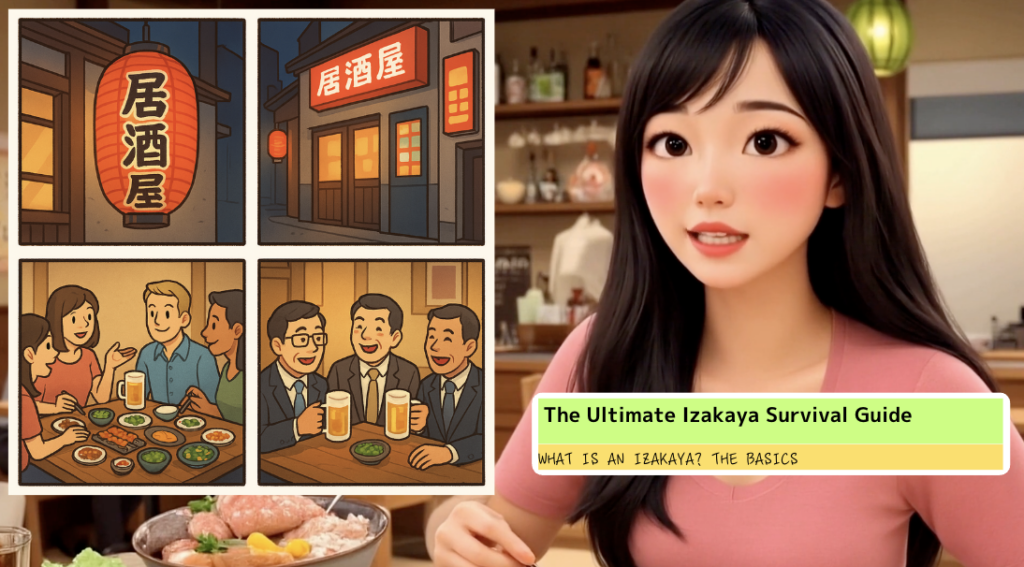
Before delving into etiquette, let’s clarify what an izakaya actually is. The word “izakaya” breaks down into “i” (to stay) and “sakaya” (sake shop), reflecting historical roots where sake shops began offering people a chance to sit down and sample drinks with small snacks on the premises.
Over time, these evolved into casual, pub-like establishments where friends and colleagues gather to enjoy drinks and share a variety of dishes. Unlike a typical restaurant that centers on individual main courses, an izakaya serves many smaller plates designed for sharing, creating a lively group dining experience.
You’ll find a wide range of styles, from big chain restaurants with bright signs and digital menus, to cozy mom-and-pop counters hidden down narrow alleys.
A red paper lantern outside is often a clear signal that you’re about to enter a space where good food, good drinks, and relaxed conversation await. In general, it’s a casual and sometimes bustling spot where locals wind down after work, catch up with friends, or celebrate life’s smaller milestones, and you can absolutely join in and soak up the atmosphere.
ENTERING THE IZAKAYA
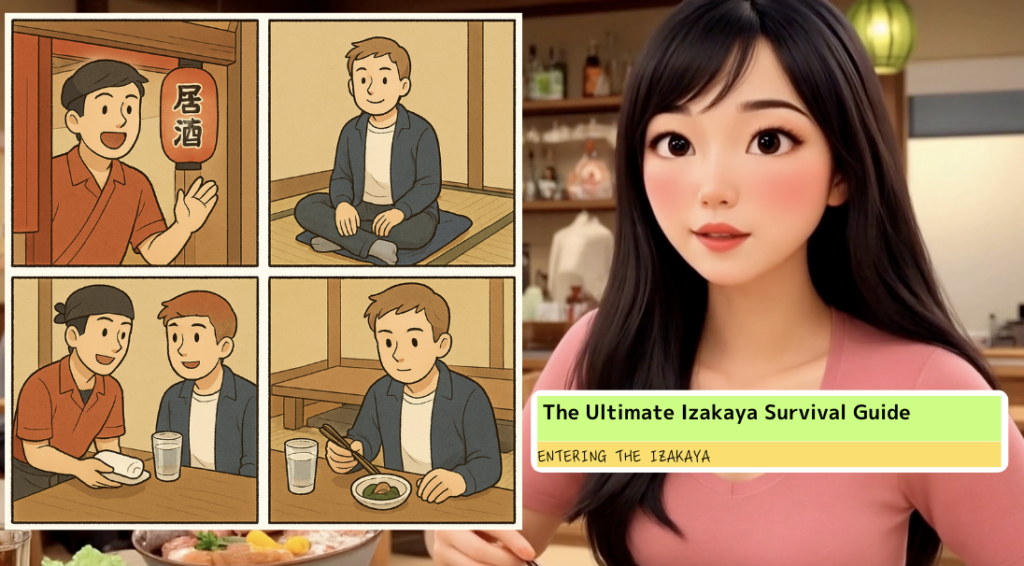
When you step into an izakaya, you’ll usually be greeted with a hearty “Irasshaimase!” which means “Welcome!” Feel free to smile or nod without worrying about a formal response—just letting them know you heard them is enough.
If you’ve reserved a table, mention your name or reservation details, and if not, let the staff know how many people are in your party. They’ll guide you to a seat, which could be a traditional tatami area where you remove your shoes, or a more standard table with chairs. If sitting on the floor is uncomfortable for you, don’t hesitate to request a table seat, as most places are happy to accommodate.
After you’re seated, the staff will typically bring a wet towel called “o-shibori” for your hands, and some cold or hot water. Although some Japanese people casually wipe their face or neck, it’s better form to use it primarily for your hands, especially if it’s a cloth towel meant to be reused. You might notice a small dish called an “o-tooshi” arriving at the table automatically—this isn’t free but is actually a cover charge served in the form of a tiny appetizer.
It might seem strange if you’ve never seen it before, but it’s a longstanding izakaya custom, so just enjoy the snack and think of it as your seat charge.
HOW TO ORDER
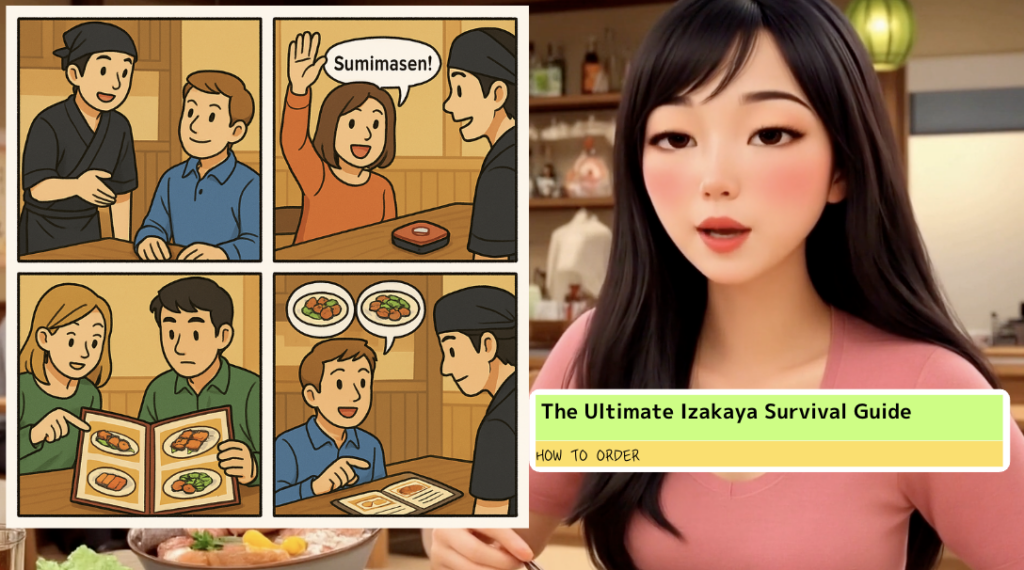
Once you settle in, the first question you’ll likely hear is about drinks. It’s common to start with “Toriaezu biiru?” which translates to something like “Shall we begin with a beer?” If beer isn’t your thing, feel free to request other beverages, including sake, shochu, cocktails, or non-alcoholic options.
In many places, especially more traditional ones, you call the server by saying “Sumimasen!” instead of waiting for them to approach your table. Some modern izakayas have a call button you can press, and many larger chain establishments provide a tablet where you can browse the menu (often in multiple languages) and order directly.
Izakayas typically feature extensive menus packed with snacks, grilled skewers, fried foods, salads, fish dishes, and more.
Since dishes are meant to be shared, start off with a few items and see how you feel before ordering more. If you see something in a picture you like, you can point and say, “Kore kudasai” (“This, please”). Don’t be shy about asking for recommendations, because the staff is usually happy to guide you through their specialty items.
DRINKING MANNERS

When the drinks arrive, wait until everyone’s glass is on the table before taking a sip. Raising glasses in unison and saying “Kampai!” is a fun moment that kicks off the evening, and drinking prematurely might look impolite to those who are used to the ritual of a group toast.
If you order communal items like bottled beer or sake in a carafe, you’ll notice that people pour drinks for each other rather than just topping up their own glass. This is a social tradition that fosters camaraderie; by pouring for someone, you’re essentially saying, “I’m enjoying having a drink with you.”
Likewise, if someone offers to pour your drink, lift your glass slightly to receive it, offer a quick “Thank you,” and never feel pressured to drink more than you want. In modern Japan, it’s increasingly recognized that pressuring someone to drink is poor form.
Simply explain that you’re pacing yourself if you don’t want continuous refills, and remember that the main goal is to have a pleasant time, not a challenge to see who can handle the most alcohol.
TABLE MANNERS WHILE EATING
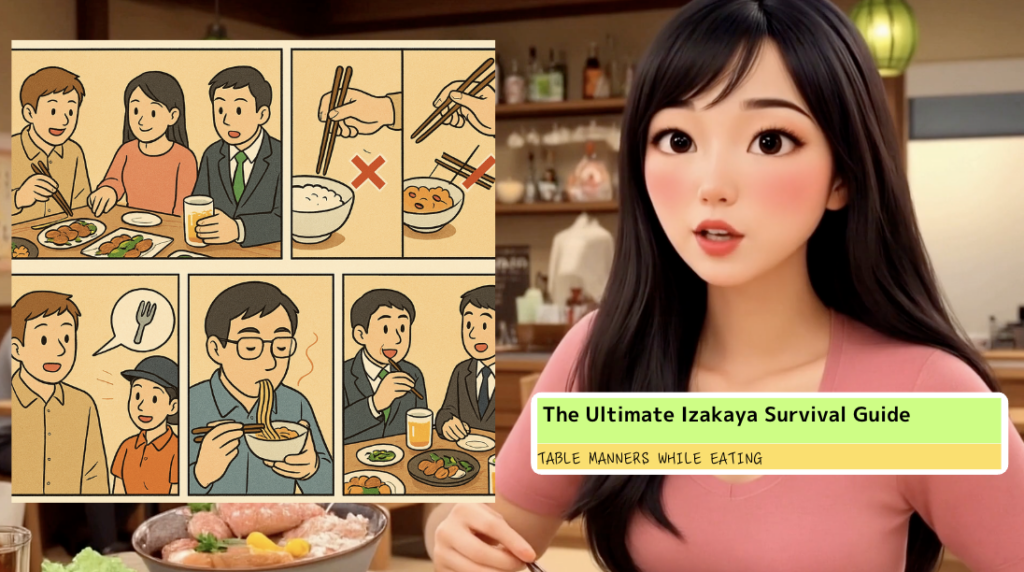
As you order food, keep in mind that izakayas are all about sharing. Dishes usually arrive in the middle of the table, and each person takes a portion on a smaller plate.
This promotes a relaxed “Try a bit of everything!” atmosphere rather than each person sticking to their own plate. Chopstick etiquette in Japan can be quite detailed, but it’s enough to avoid obviously impolite actions such as stabbing your food outright or passing food from chopstick to chopstick.
If you find it tricky to handle some dishes with chopsticks, politely ask for a fork—most places will happily provide one. Japanese custom also allows you to lift small bowls of rice or soup to your mouth so that you don’t have to lean down close to the table.
Slurping noodles is not considered rude here; many Japanese believe it enhances the flavor, particularly for ramen or soba, so feel free to give it a try if you’re comfortable. In short, keep it polite, be mindful of shared plates, and do your best to observe what those around you are doing.
MAINTAINING THE MOOD & CONVERSATION
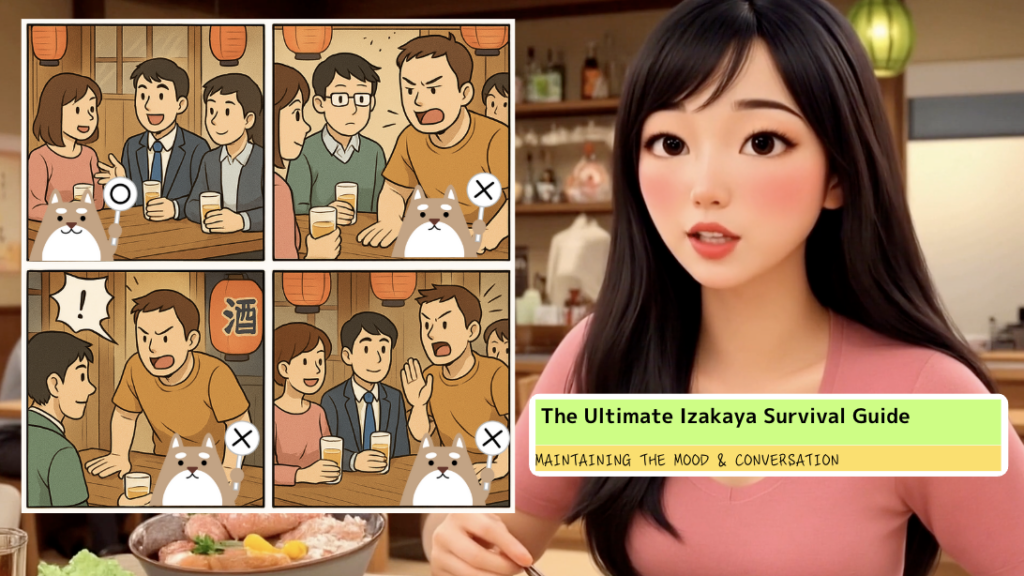
Izakayas are social spaces, so being considerate of the overall atmosphere is just as important as any formal rule. The Japanese concept of “reading the air,” or “kuuki o yomu,” simply encourages you to notice if you’re dominating the conversation, if others are trying to speak, or if your volume is disrupting neighboring tables.
Offer attentive listening by using short acknowledgments like “Oh, really?” or “Wow, that’s interesting,” which helps show genuine engagement rather than leaving people wondering if you’re bored. For initial meet-ups, you might want to steer clear of heavy topics like politics until you know the group’s comfort level.
Food, travel stories, or observations about life in Japan are great conversation starters that are less likely to cause awkward tension.
While being lively and fun is definitely encouraged, take care not to swing into rowdiness—shouting, pounding the table, or standing up and being too boisterous can alarm those around you. If you need to take a call, stepping outside or away from the table is seen as more polite than loudly chatting on your phone right there.
PAYING THE BILL AND LEAVING
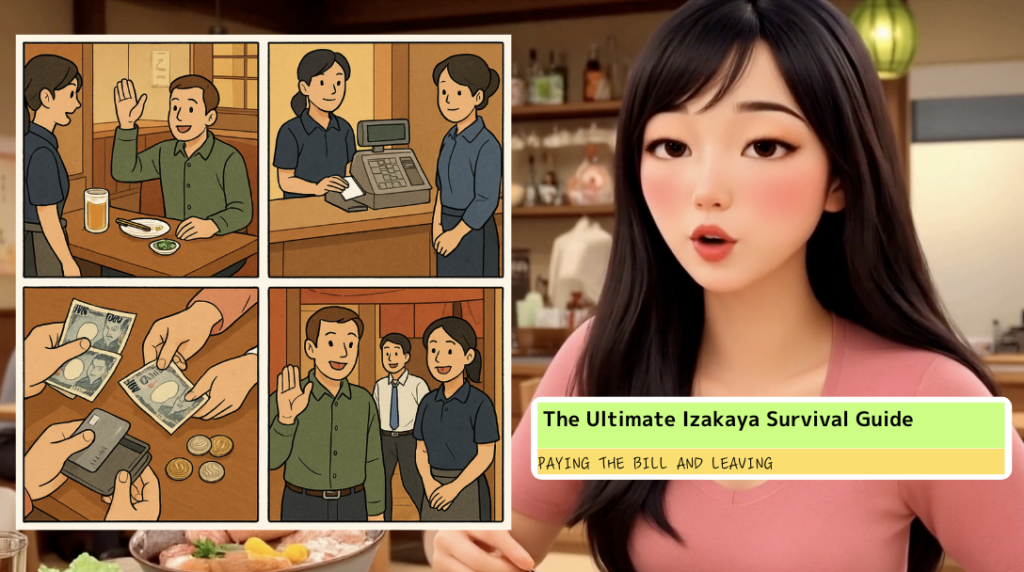
When it feels like the right time to wrap up, you’ll usually request the check by saying, “O-kaikei onegai shimasu,” which means “Check please.” In many traditional izakayas, you bring a paper slip (called a denpyō) to the front register; the staff won’t often bring the check to your table unless it’s a more modern chain.
Cash is still common, although credit cards are gaining ground, especially in urban areas. Be prepared with yen just in case, since smaller independent establishments might not accept cards. One of the most surprising aspects for newcomers is that there’s no tipping in Japan, so you only need to pay the amount stated.
Leaving extra money can result in a staff member chasing after you to return your change. When it comes to splitting the bill, groups usually do “warikan” (splitting the total) among themselves, rather than asking the restaurant to handle separate checks.
If a more senior person insists on paying for everyone, it’s typically polite to accept their kindness rather than pushing money into their hands. After settling up, say “Gochisō-sama deshita!” (“Thank you for the meal!”) as you leave.
The staff will usually return your words with a smile and a friendly farewell, and that simple exchange is your cultural equivalent of leaving a tip.
COMMON MISTAKES & NG (“NO GOOD”) BEHAVIORS
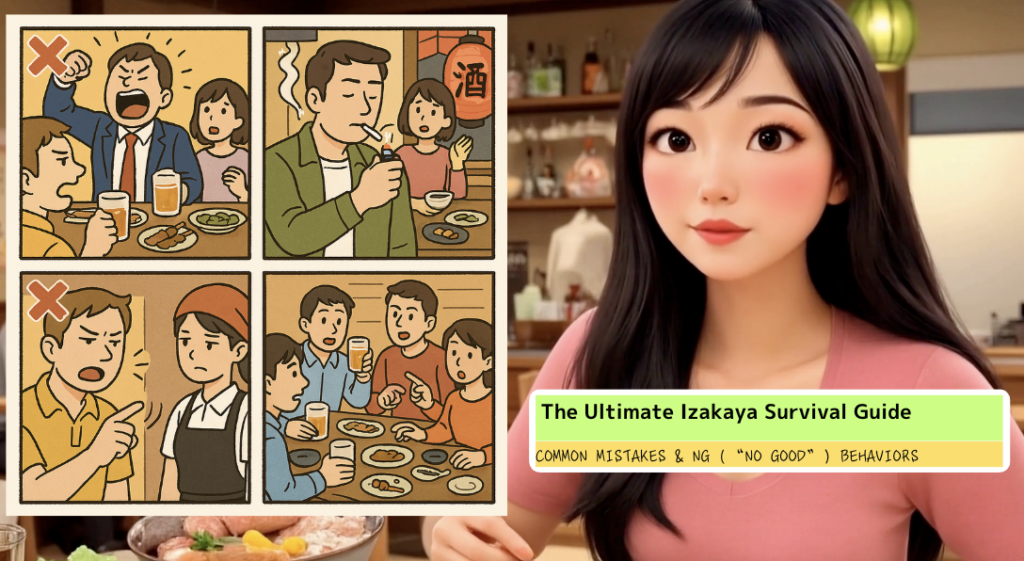
While an izakaya is a casual environment, there are a few recurring mistakes that travelers and newcomers tend to make.
One mistake is getting too loud or rowdy, especially if you come from a culture where bar settings might be noisier. Izakayas can be lively, but becoming the only table that everyone else stares at is not ideal.
Another error is lighting up a cigarette without asking if it’s allowed. Many places have gone smoke-free or provide designated smoking areas, so confirm before lighting up. Being rude to staff by speaking in a bossy tone or snapping fingers to call them over can also leave a bad impression, so remember that “Sumimasen,” “Onegai shimasu,” and “Arigatō” work wonders.
Over-ordering and wasting food is something to avoid as well; it’s usually better to order a few plates at a time and then add more as you go. Confusing others’ glasses or plates with your own can happen during a busy meal, so double-check that you’re sipping your own drink and not someone else’s.
Also, some izakayas have time limits (often two hours) during busy periods, so it’s courteous to keep track rather than camping out without ordering anything new. At the register, make sure you have your payment ready so that you’re not stuck rummaging for coins and holding up the line. These may sound like a lot of rules, but most are simply about politeness and consideration for others.
REGIONAL DIFFERENCES & FUN FACTS

Regional variation adds an extra layer of charm to izakaya culture. In Tokyo, that automatic appetizer is often called “o-tooshi,” while in Osaka and other parts of western Japan, you might hear it referred to as “tsukidashi.” The concept is the same, so don’t be alarmed by the different name.
You’ll also find that each area has its own local specialties, such as fresh seafood and lamb barbecue (Genghis Khan) in Hokkaido, or spicy cod roe and offal hotpot in Fukuoka. Exploring these items is a fun way to discover Japan’s diverse food culture.
You can choose from large chain izakayas, which may offer English menus and digital tablets for a seamless experience, or smaller independent establishments where the atmosphere feels personal and unique, even if the menu is only in Japanese.
Standing izakayas, known as “tachinomi,” are also worth trying if you want a quick drink at an even cheaper price point. Many places have a final call known as “last order” (L.O.) around 30 to 60 minutes before closing, so keep that in mind if you want one more drink or snack. And finally, don’t be surprised if your Japanese friends propose going to a “nijikai,” or second party, at a bar or karaoke spot after you settle the bill at your first izakaya. That’s all part of the experience.
CONCLUSION
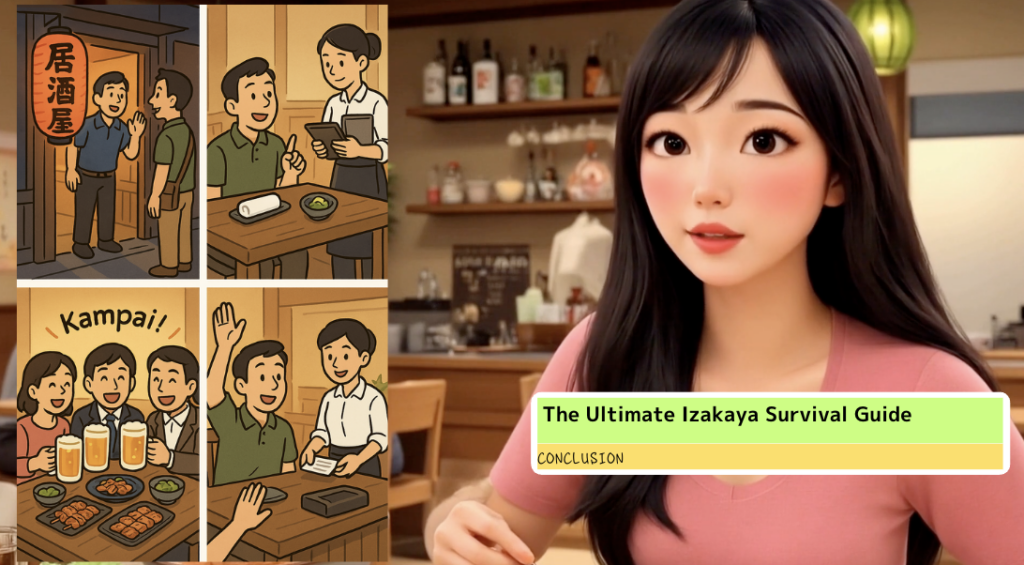
Now that you’ve made it through the complete izakaya guide, you should be well-equipped to walk into any izakaya in Japan and make the most of your visit. You know how to greet the staff, handle the o-shibori, share dishes, order drinks, offer a polite toast, and settle the bill without stepping on too many cultural toes.
Keep in mind that, although there are many pointers and customs to observe, you don’t have to be perfect; showing genuine interest, respect, and a willingness to learn will go a long way. People generally appreciate your effort, even if you slip up on a minor point.
Thank you for watching, and enjoy your izakaya adventures. Don’t forget to share your own stories in the comments. Kampai, and have a wonderful time exploring Japan’s beloved dining culture!


